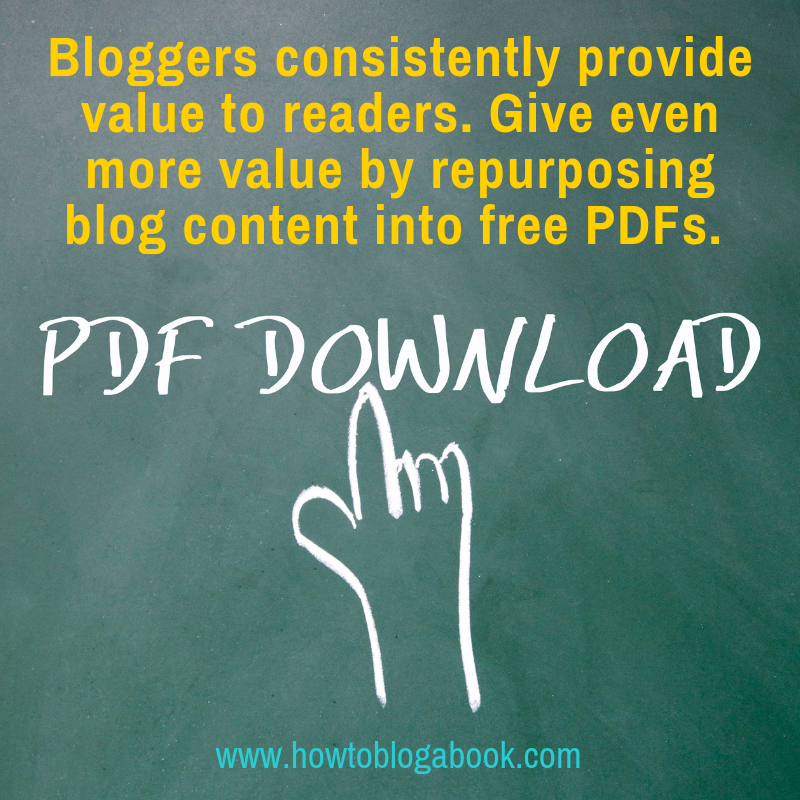One of the best ways to develop super fans and build your blog and book readership is to give…give…and give some more valuable content. You are already providing valuable blog posts and books, so what else can you give your readers? Free PDFs. Jay Artale (@BirdsOAFpress), a digital nomad and full-time writer and blogger, has successfully used this tactic. And today she shares her advice on how you can do the same.
Nonfiction books and blog posts provide a valuable source of shareable content. Therefore, as a blogger and author, don’t miss the opportunity to create free PDF downloads to help your readers.
I create multiple companion downloads and templates for my nonfiction books by identifying useful information that can easily be converted to a standalone reference sheet. To do so, I put myself in my reader’s shoes and think of all the ways I can segment my existing content to streamline their learning curve.
If what I’m doing is helping them, I hope they’ll return the favor by spreading the word about my content and books by sharing information about them across their social networks.
Give Readers Free PDF Downloads
My long-term goal is to create companion workbooks for each of my nonfiction books, but creating workbooks can be a monumental task. That’s why I use an approach similar to blogging a book—I create individual PDF downloads to support my books, blog posts, and podcasts, which I can then consolidate into companion workbooks.
Creating these one or two-page PDFs is an excellent way of:
- Giving your readers something for nothing to help them achieve their goals.
- Building your mailing list by offering a free “gift” in return for signing up to your email list.
- Building a level of integrity with your audience by showcasing your knowledge and expertise.
- Raising awareness of your books, websites, podcast, and website content.
- Providing you with the foundational content to create and self-publish a full-length workbook at a later date.
I create two different types of PDFs: Quick Reference Sheets and Worksheet Templates.
1. Quick Reference Sheets
My quick reference sheets are segments of content from my blog or book presented in a one or two-page handy cheat sheet. While a reader is working their way through my how-to advice guides, the core content can be consolidated into a PDF for quick reference. This is especially useful for readers who bought the ebook version of my guides, which are more challenging to navigate than a paperback with a handy index.
2. Worksheet Templates
Worksheet templates are ideal for how-to content, especially when they direct your reader to brainstorm ideas or research information. It’s easier for them to print out a pre-formatted worksheet, which allows them to complete the task you’ve set before them. You also can include prompts or reminders of the key information from the original content.
I provide an example of a completed worksheet in my templates, followed by a blank template to fill in. I know my reader’s time is precious, so I provide these examples to avoid any ambiguity about what’s expected and to take the guesswork out of filling in the blank template.
What PDFs could you create?
The first book in my How to Write and Self-Publish a Travel guide series focused on the planning process of writing a travel guide. For each chapter, I created a companion reference sheet; a worksheet template; and in some cases, a PDF that combines the two. During my blog-a-book process, I identified what content would make ideal PDFs, and I created a free downloads page on my website. These included a reference sheet explaining the difference between an angle and theme, a worksheet to complete competitive research on Amazon, and worksheets for defining your target audience, content scope, and descriptive statement.
I included a link within the blog post that directs readers to this landing page. Additionally, I included links to this page at the beginning and end of my book as well as within the relevant chapters.
No matter what your nonfiction niche, your book will contain cornerstone content that is a natural fit for summarization into a PDF. If you’ve included a list of recommended websites, podcasts, software, or tools you rely on, this content makes an invaluable cheat sheet for any newbie in your niche.
When you put your reader first by providing free PDFs, they’re more likely to share your content with their audience, and you’re one step closer to building a brand ambassador network.
Have you used free PDFs to provide more value to your readers? If so, tell me about them in a comment below. If you haven’t done so, leave a comment including your ideas for doing so in the future.
About the Author

Jay Artale abandoned her corporate career to become a digital nomad and full-time writer. She’s an avid blogger and a nonfiction author helping travel writers and travel bloggers achieve their self-publishing goals. Join her at Birds of a Feather Press where she shares tips, advice, and inspiration to writers with an independent spirit.


Leave a Reply